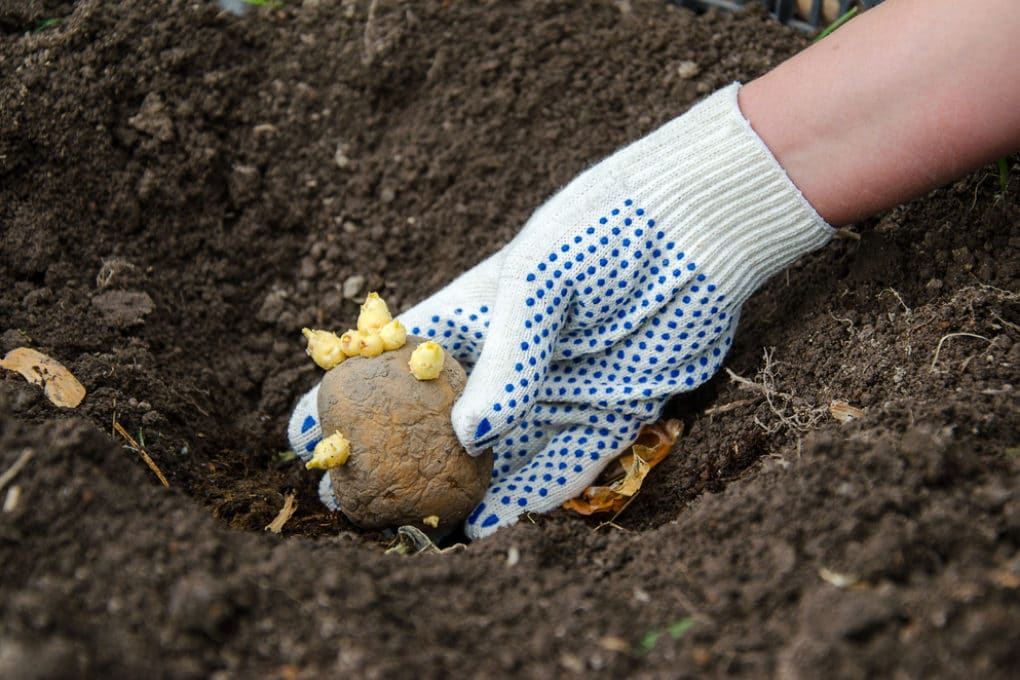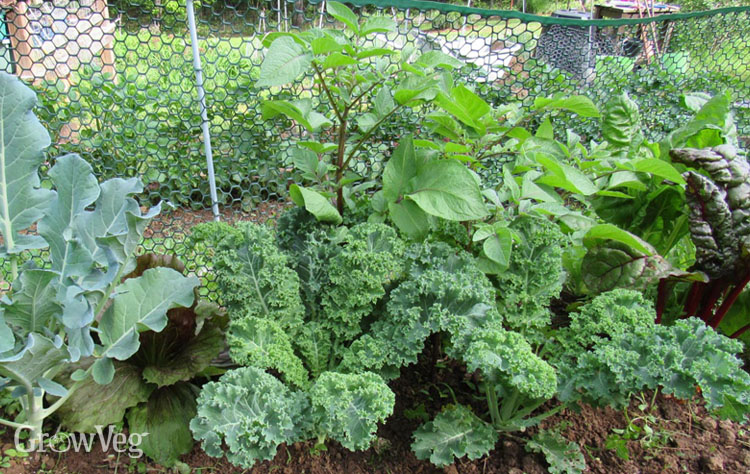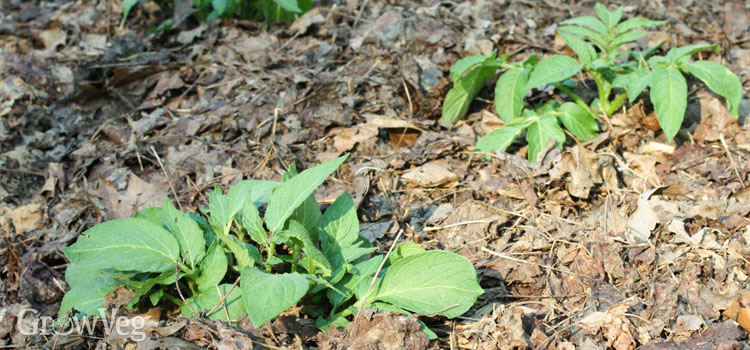No matter how hard I try, little potatoes get past me on harvesting day, and then spring to life as volunteers among cabbage or corn the following year. The volunteer potatoes are robust plants, because they are growing the way potatoes want to grow, as perennials. Native to the Andean Mountains in South America, potatoes are very much perennials that die back in winter and regrow from fat storage roots (potato tubers) when the weather warms in spring.
Fall is a great time to plant potatoes for an early harvest next year By planting seed potatoes in the fall, you can get a head start on the growing season and avoid issues like bad weather delaying spring planting In this complete guide, I’ll cover everything you need to know about selecting, planting, and caring for seed potatoes in the fall.
Why Plant Seed Potatoes in the Fall?
There are several advantages to fall planting potatoes:
-
Earlier Harvest: Fall planted potatoes mature earlier next spring, allowing you to harvest weeks before spring planted potatoes. You can enjoy fresh potatoes much sooner.
-
Higher Yields With extra months of growth before summer, fall plantings generally produce much higher yields than quick growing spring plantings
-
Fewer Pests: Emerging earlier than spring plantings, fall potatoes avoid the peak populations of pests like potato beetles.
-
Better Soil Prep: Fall planting gives you time to amend and prepare soil before spring growth spurts.
-
Weed Suppression: Emerged potato plants in fall help crowd out early spring weeds.
-
More Favorable Conditions: Potatoes thrive in cool, moist soils. Planting in fall allows plants to take advantage of these optimal spring conditions right from the start.
Choosing Seed Potatoes for Fall Planting
Picking the right seed potato varieties is crucial for fall planting success:
-
Disease Resistant: Seek certified disease-free varieties resistant to common potato diseases in your area. Avoid planting potatoes from your summer crop which may harbor disease.
-
Small Tubers: Choose smaller 1-2 inch potatoes as they establish quickly compared to large 4+ inch tubers.
-
Good Skin Set: Select firm, blemish-free potatoes that have cured 2-3 weeks post harvest. Soft, wrinkling potatoes often decay.
-
Vigorous Sprouts: Ideal potatoes will have short, thick sprouts showing health and vigor. Avoid long, thin sprouts.
-
Climate Match: Pick varieties suited for your climate’s season length and winter conditions. Consult local growing guides.
-
Early Maturing: Prioritize early and mid-season potatoes over late season long maturing types for fall planting.
Some excellent fall potato varieties include:
-
Early: Dark Red Norland, Yukon Gold, Red Gold
-
Mid: Purple Viking, Carola, Katahdin
-
Fingerlings: Ruby Crescent, French Fingerling, Austrian Crescent
When to Plant Potatoes in Fall
Time fall plantings about 110 days before your first expected frost. In warmer zones, start as early as July/August. In cooler areas plant September through October.
Tuber formation slows above 80°F, so target planting when daytime temperatures are consistently below this level.
Aim for 8-10 weeks of growth before cold weather halts above ground activity. Underground growth continues through winter.
How to Plant Potatoes in Fall
Step 1) Pick a sunny, wind sheltered site with well-draining soil. Avoid areas potatoes grew in past years.
Step 2) Loosen soil 10-12 inches deep. Mix in 2-4 inches of compost. Get pH between 5.8-6.5.
Step 3) Dig 8-10 inch trenches 12-18 inches apart.
Step 4) Place seed potatoes 10-12 inches apart in trench with sprouts facing up. Cover with 4 inches of soil.
Step 5) As sprouts emerge, keep backfilling trench with soil until level with bed.
Step 6) Water newly planted potatoes well. Maintain even moisture as plants establish.
Step 7) Once plants reach 12 inches, mound soil/mulch around stems to protect tubers from sunlight.
Step 8) Monitor for Colorado potato beetles & other pests. Remove immediately.
Step 9) Side dress extra compost/fertilizer when plants are 12-18 inches tall to boost yields.
Step 10) Avoid overwatering. Allow soil to dry slightly between waterings.
Step 11) Delay harvesting for 2-3 weeks after vines die back to allow tubers to cure.
Caring for Fall Planted Potatoes
Proper care is vital for robust fall potato plants:
-
Amend soil with aged compost/manure to get plants off to a strong start.
-
Consistent moisture is key. Water when top 1-2 inches of soil are dry.
-
Monitor closely for emerging Colorado potato beetles. Hand pick adults & larvae.
-
Hill stems with soil/mulch once 12 inches tall to prevent tubers greening from light exposure.
-
Applying an organic fertilizer boost when plants are 12-18 inches tall fuels maximum growth.
-
Weed control is critical early on. Weeds compete for water/nutrients. Mulch helps suppress weeds.
-
Allow tubers to cure in ground 2-3 weeks after vines die back for best skin set and storable potatoes.
Avoiding Pitfalls
Steer clear of these common missteps when fall planting spuds:
-
Planting too late – Target 8-10 weeks of growth before cold stops growth.
-
Poor drainage – Pick raised beds/hills. Avoid heavy clay or compacted soils.
-
Using diseased seed potatoes – Always start with certified disease-free tubers.
-
Inadequate soil prep – Double dig and mix in ample compost to enrich soil.
-
Planting too deep – Place seed potatoes only 4 inches deep, sprouts facing up.
-
Insufficient watering – Potatoes require consistent moisture for quality tuber development.
-
Excess nitrogen – Go easy on high nitrogen fertilizers which cause excessive foliage over tubers.
Ready for Robust Fall Spuds?
Now you have all the information you need for a thriving fall potato harvest! Pay close attention to selecting the right varieties suited for your climate. Properly preparing soil, timely planting, and attentive care will ensure a bountiful crop of fall planted spuds.

Can You Plant Potatoes in the Fall?
You can mimic nature’s natural plan for potatoes by planting potatoes in the fall. Not all of them – your big planting can wait until spring. But fall is the time to plant the little potatoes that have turned green in storage, or the ones you found one day while digging in the garden and left outside in a dirty pail. Gardening experts in Wisconsin recommend fall potato planting so the plants can establish themselves ahead of cutworms and weeds in spring. I like having a good use for my puniest potatoes.
You can expect success planting potatoes in the fall as long as your soil gets cold and stays cold in winter, with temperatures 8 inches (20 cm) below the surface staying below 48°F (9°C). Buried potato tubers start growing as soil temperatures rise above 50°F (10°C). Your garden gets a vote, too. If you often see volunteer potatoes in your garden, planting potatoes in the fall should work out well.

Please note: If you live in a mild winter climate where the soil does not chill down, it is best to wait until late winter to plant potatoes. The plants can then enjoy uninterrupted growth in mild spring weather and make a crop before the weather gets hot.
Seed Potatoes for Fall Planting
You won’t find seed potatoes at nurseries this time of year, so you will need to come up with your own. If you don’t have some little sprouters left from your summer harvest, you can prep and plant small potatoes from the market. Before planting, let the potatoes sit in a warm, well-lit place to green up for a few days. Green skins on potatoes are evidence that the tuber has equipped itself with bitter solanine compounds that make it unpalatable to critters.

Whether they are large or small, keep potatoes whole when planting potatoes in the fall. Cut potatoes are much more likely to rot or get eaten by voles compared to whole potatoes. Spring-planted potatoes grow so fast that cutting does little harm, but potatoes planted in cold soil should be left whole to give them the best chance at survival.
There are plenty of leaves around in the autumn, and they make a great mulch for potatoes planted in the fall. A leaf mulch cushions the soil from compaction caused by heavy rain, and keeps the soil cool through periods of mild winter weather. Some gardeners put leaves directly into the planting trenches when planting potatoes in the fall, but this is merely an option. The important thing is to have the surface well covered to prevent weeds and erosion, but not mulched so deeply that the potatoes think winter is over.

Some gardeners report earlier emergence of fall planted potatoes, but mine tend to be a bit late, perhaps because I plant them quite deep, about 10 inches (25 cm) below the surface. Here I am copying the potato’s ploy, because most of the volunteer potatoes in my garden grow from tubers buried beyond the reach of my hand spade, appearing after the space has been cultivated and planted with something else.
Why not just let the volunteer potatoes grow? Leaving potatoes to grow in place sets the stage for soil-borne diseases to develop, and here we are talking about potato problems like nematodes and scab and pink rot that never manifest when soil is given restorative breaks between potato crops. Potatoes that are intentionally planted in fall get a fresh location and time to settle in, a win-win strategy for a nice little crop of summer potatoes.
Planting Potatoes in Fall // Any Climate!
FAQ
Can seed potatoes be planted in the fall?
Don’t forget your seed potatoes! Growing potatoes from seed potatoes in Zones 9 and 10 during the fall can be rewarding, as these regions provide a favorable climate for this cool-season crop. Some gardeners miss out on planting seed potatoes in the fall, mistakenly thinking they must wait till spring.
Can I use grocery store potatoes as seed potatoes?
-
Cost-effective:Grocery store potatoes are a readily available and cheaper option compared to buying certified seed potatoes.
-
Potential for a harvest:If the potatoes are healthy and have good sprouts, they can still produce a crop.
How late in the fall can you plant potatoes?
When to Plant Fall Potatoes. Late potatoes work well for winter storage. The best time to plant these varieties is about 110 days before the first expected freeze, which may be as early as July in some regions. Tuber formation will slow or stop when soil temperature reaches 80 degrees Fahrenheit (26.7 C.).
Can I just throw potatoes in the ground?
-
Why it works:Potatoes are actually tubers, which are underground stems that store food. When planted, they can sprout and grow into a new plant, producing new potatoes.
-
Best Practices:
- Seed Potatoes: Ideally, use “seed potatoes,” which are specifically grown for planting and are usually disease-free.
- Cutting and Sprouting: If using larger potatoes, cut them into pieces with an eye on each. Allow the cut surfaces to dry for a few days before planting to prevent rot.
- Planting Depth and Spacing: Plant the potato pieces (or whole small potatoes) in a trench or hole about 5-6 inches deep. Space them 8-12 inches apart, depending on whether you are growing small baby potatoes or larger ones.
- Soil and Sunlight: Potatoes prefer slightly acidic soil (pH 5.8-6.5) and plenty of sunlight (at least 6 hours a day).
- “Hilling” (Optional): As the plants grow, you can “hill” them by adding more soil around the base of the stems to encourage the formation of more potatoes.
- Seed Potatoes: Ideally, use “seed potatoes,” which are specifically grown for planting and are usually disease-free.
Can you plant potatoes in the fall?
Yes, you can plant potatoes in the fall. However, you’ll need to prepare by saving your own seed potatoes from a previous harvest, as they are not typically available in garden centers during the fall in northern regions.
How to plant potatoes in autumn?
Planting potatoes in the autumn is a lot like planting in the spring. Here’s how to do it: Time it takes to plant in autumn: About 30 minutes. — shovel. Step #1: Buy seed potatoes. You may save your own seed potatoes. If this is the case, you are golden. Otherwise, you will have to buy them online because few local stores have them in the fall.
Are fall-planted potatoes a good crop?
In short, fall-planted potatoes get a head start on growth, maturity, and pest avoidance — all resulting in higher yields. Now let’s look at how to select the right seed potatoes for fall planting success. The most fundamental factor in a prolific fall potato harvest is starting with high-quality seed potatoes. Here’s what to look for:
How do you plant a fall potato crop?
Side dress extra compost or organic fertilizer when plants reach 12-18 inches tall to fuel growth through harvest. Get your fall potato crop off on the right foot by following these simple planting guidelines. Avoid pitfalls like overwatering, planting too deep, or choosing diseased seed tubers.
How do I choose the best seed potatoes for a fall harvest?
Always opt for certified seed potatoes to reduce the risk of disease. Choose varieties that suit your climate and desired harvest time. Varieties like Yukon Gold or Red Norland are great for a fall harvest.
Should you grow your own potatoes for a fall harvest?
Growing your own potatoes for a fall harvest can be incredibly rewarding and a fun addition to your autumn gardening activities. I’ve found that getting the timing right is crucial. In general, you want to plant your potatoes late enough so they mature as the weather starts to cool, but early enough to avoid the first frost.
